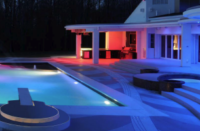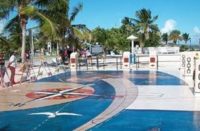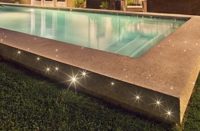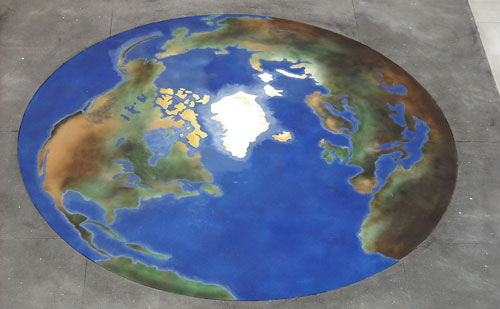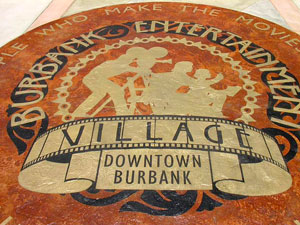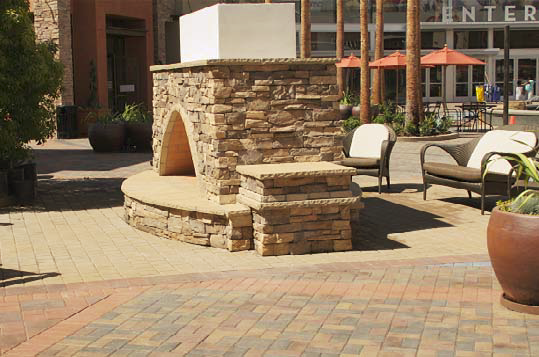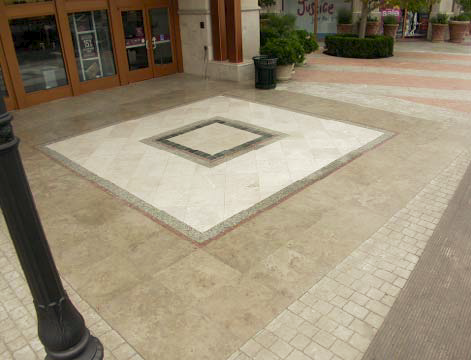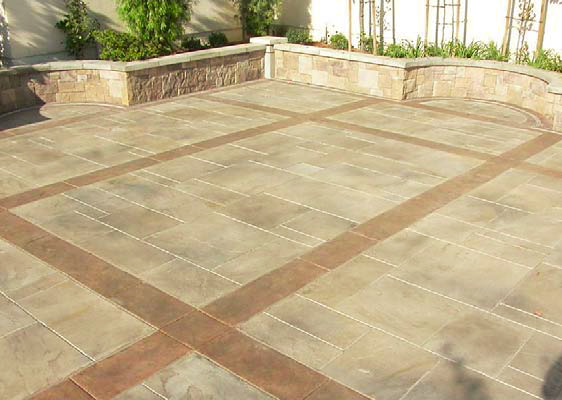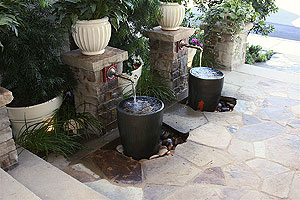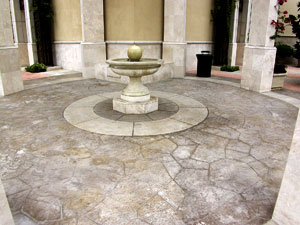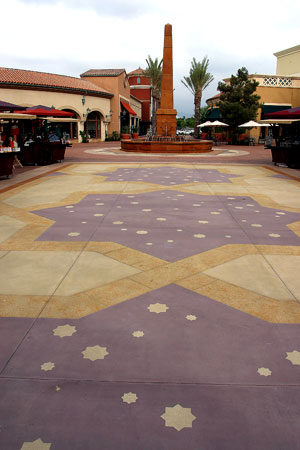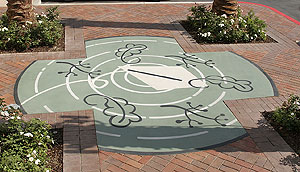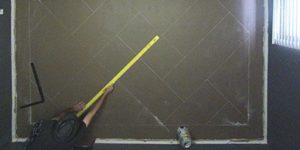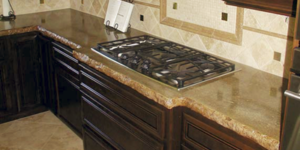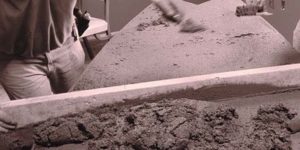Houses with multimillion-dollar price tags and generous budgets for architectural concrete flatwork just aren’t popping up as much as they used to, even in Southern California. Fortunately, that realization hit the decision-makers at PBC Companies sooner than it did a lot of the nation’s leading economists.
“We used to be about 80 percent involved in high-end residential, but we started slowly shifting our emphasis to commercial clients as early as 2000,” says Bill Larson, director of quality assurance and field development for PBC, one of the largest regional decorative concrete subcontractors in the country. “As a result, we’ve got 80 foremen at work today, while our residential competitors have two or three.”
With some 700 total employees and four offices in Southern California, PBC covers a territory anchored by Ventura County to the north and the Mexican border to the south. Recently, the company added an office in the Phoenix area at the invitation of a landscaping firm that is a satisfied customer.
At every location, PBC offers a portfolio of services in architectural concrete, masonry and interlocking pavers. “We can run all three trades at each site, and we usually handle at least two out of three wherever we go,” says Larson.
That wasn’t always true. PBC, which also does business as Peterson Brothers Construction, was an all-concrete contractor for its first decade in business. It was founded in 1983 by brothers Elden and Kerry Peterson, both of whom still hold top management positions. “We’d do exterior flatwork for (luxury home) models, and that was a good deal of our business until 1994, when we started working with interlocking pavers,” says Larson. “That look had been very popular in northern California, and we wanted to introduce it down here.”
It was also during this time that PBC began to offer masonry. Today, a full complement of services is available to a client base that includes shopping centers, luxury hotels, multiunit apartment complexes, high-end housing developments, corporate campuses, retail centers and even a couple of well-known theme parks.
But the company’s emphasis is still on stamping, staining, polishing, pervious concrete and other decorative concrete specialties. “That’s 50 to 60 percent of the work we do,” says Larson, who explains that the company doesn’t have as much competition in decorative concrete as it does in masonry and pavers. “There just aren’t as many people doing it, and that’s a good thing for us.”
Teaching quality
PBC places such an emphasis on craftsmanship — its competitive edge — that it launched a sort of university of quality construction 12 years ago. One of Larson’s principal responsibilities is to teach. He heads up “about 99 percent of the classes,” he says. He uses formal classrooms, PowerPoint presentation materials and white boards, and his students are motivated. “They’ll ask me if they can study anything for the tests, and I tell them all they have to do is bring their construction I.Q. Either you’ve got it or you don’t.”
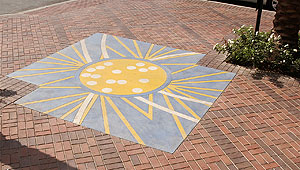 |
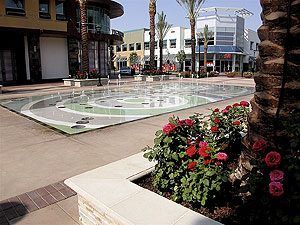 |
Larson runs a full curriculum of courses for his foremen, supervisors, laborers and apprentices. Subjects range from blueprint reading to job management. He offers certification programs in porch and swimming pool construction and even teaches a course on defensive driving, a topic no doubt inspired by the challenges of living and working in a region of the country notorious for its widespread geography and congested freeway-based transportation system.
PBC has also taken an interest in training in green construction. The company has joined the United States Green Building Council and its employees are learning about recyclable building materials and sustainable, Earth-friendly construction techniques.
Take pervious concrete, for instance. The highly porous building material allows rainwater to soak through “like a sponge,” says Larson. “It penetrates to a rock subgrade and into the water table rather than running off to the ocean.”
The only drawback to pervious, says Larson, is that, in its natural, gray state, it “looks like crappy asphalt.” So PBC artisans have taken to brightening its appearance with unique coloring techniques and coating enhancements. Another “green” trick Larson and his students have picked up along the way is the use of white concrete for its light-reflective quality. It doesn’t retain the sun’s heat like black concrete, potentially reducing summer energy costs, particularly in hot and perpetually sunny Arizona.
Luxury driveways
While PBC Companies has reconfigured its residential-to-commercial project mix over the last eight years, the home segment of the market has hardly been abandoned. The Rancho Santa Fe project is a San Diego development featuring 10-acre to 15-acre parcels. “More was spent on some of the driveways than most people can afford to pay for their entire homes,” Larson says.
So what do you get for a $200,000 driveway? Interlocking pavers. A lot of pavers. “Some of those driveways are more like streets,” he says.
Another noteworthy example is the firm’s work at the exclusive Pelican Hill in Newport Beach. “We put in the sidewalks, wall caps in the public areas and the curbs and gutters,” says Larson.
Colored with an acid-washed stain, these curbs and gutters look a lot nicer than those on most streets. Which is what you’d expect in a development where one castle currently available for sale comes with nine bedrooms, 20 bathrooms and a price tag of $21,995,000. And it’s not even the most expensive property in the neighborhood.
Thinking ahead
So what does the future hold for PBC Companies? Larson thinks that the popularity of eco-friendly pervious concrete will grow over the next half decade, and that will, in turn, expand the need and opportunity for training.
This teacher would seem to have his work cut out for him for the next several years.
“You can get all kinds of effects in staining pervious, because stain doesn’t cover like paint,” he says. “Every surface imperfection comes through. That can be a good thing or a bad thing, depending on the look you’re after. You have to remember to patch first what you don’t want to see once it’s stained. It’s a matter of knowing what you’re doing.”
www.pbc-online.com
